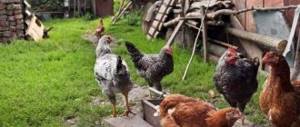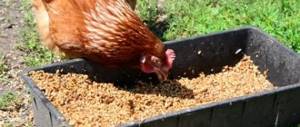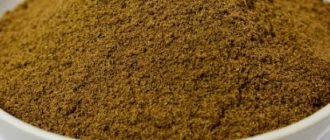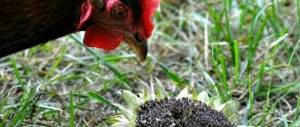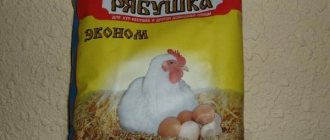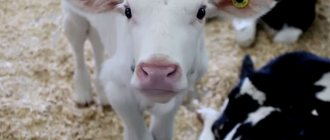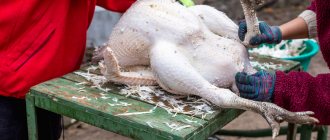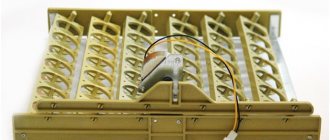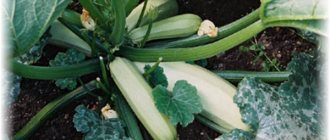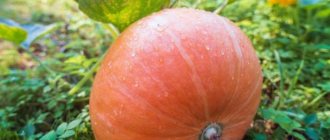Feeding chickens with bone and meat and bone meal
The diet of animals requires the presence of vitamins and mineral supplements that have a positive effect on the health of birds. Meat and bone meal for chickens is a simple and inexpensive feed. The supplement is safe and has a great effect on your physical condition if you carefully follow the instructions.
Meat and bone meal for chickens
Bone meal is good for chickens, it is rich in vitamins. You can ensure the quality of food when choosing a product, paying attention to the basic requirements:
- powdery structure;
- color from milky to light brown;
- uniformity of granules;
- the smell is specific, but not putrid;
- flowability.
You should not give chickens yellow flour - this indicates the addition of feathers to the product, which can cause serious illness in laying hens and broilers. The green color will indicate the addition of soy to the feed, which causes protein deficiency and provokes cannibalism. The composition should not contain large granules or items of unknown origin.
Based on quality, food is divided into three classes, the best of which is the first - it contains a minimum amount of harmful fats. The moisture content of the first class additive should not exceed 7%.
Among the ingredients that make up bone meal should be only crushed bones, muscle tissue and animal meat, water, and ash. Other products in the composition are not allowed.
The food contains biological substances - choline, thyroxine, calcium, sodium, riboflavin, phosphorus, nicotinic acid. The quality of the ingredients is regulated by the established state standard, and the exact composition is reflected in the instructions for use, which are located on each package.
There are cheap feeds on the shelves, but their use threatens to deteriorate the health of the birds. The price of a good quality additive is above average, but such meat and bone meal will improve the egg production of laying hens, the power of broilers and accelerate the development of chickens.
Feed making
Flour production consists of 6 stages:
- The bodies of deceased cattle representatives are processed and cut into pieces, thoroughly boiled, and then allowed to cool.
- The resulting mixture is crushed into fine dust.
- The powder is sifted to prevent large granules from getting into the finished product.
- The mass is passed through a magnetic separator to improve quality and remove metallic impurities.
- To prevent premature rotting, the additive is treated with antioxidants.
- The finished product is packaged.
A lighter version of the supplement can be made at home.
Feeding rules
Bone meal is useful; it can be added to the regular diet, combined with mash or feed. The daily dosage should not exceed 7% of the chickens' total food intake. Exceeding the norm provokes the development of diseases in birds - uric acid diathesis and amyloidosis.
Adult chickens should be given up to 11 g of supplement per day.
Meat and bone meal is no less useful for chickens than for mature chickens. When feeding chicks, you need to follow a special dosage that corresponds to each period of life:
- in the first five days, feeding is prohibited;
- from 6 to 10 days, chickens begin to be given 1 g of the additive;
- from 11 to 20 - the dose increases to 2 g;
- from days 21 to 30, the amount of feed reaches 3 g per day per head;
- from 31 to 63 - chickens are given up to 6 g of flour.
Starting from the 64th day of life, the chicks are given food together with the adults.
Adding the product to the diet of chickens ensures the proper development of their body and accelerated skeletal formation. For laying hens, meat and bone meal is of particular benefit - it maintains health, facilitates the reproduction process and increases power.
The additive cannot be given instead of regular feed - this will cause a deficiency of the required microelements and will negatively affect egg production and the general condition of the bird population. All instructions for calculating the dosage are contained in the instructions for use, which should become the main guideline for choosing feed and creating a diet for chickens.
How to properly feed meat and bone meal to chickens
The dosage and method of application depend on the age and weight category of the bird. The meat and bone product can be mixed with wet mash and added to feed and grain. Give once a day.
It is unacceptable to mix flour with warm water, since at temperatures above room temperature the additive loses some of its beneficial properties.
For replacement young stock
Meat and bone supplements are allowed to be introduced into the diet of chickens from 2 weeks of age. Use 10 g of flour (2 teaspoons) for 10 chickens under 1 month of age. The norm of bone meal for young animals over 4 weeks old is 3 g per chick or 30 g per flock of 10 birds.
For laying hens
Pullets from 4 months and adult laying hens are given 7-8 g per head or 80 g of meat and bone meal is added to 1 kg of feed. During the molting period, the amount of meat and bone meal for chickens is increased to 100 g per 1 kg of feed.
For broilers
Meat and bone meal is introduced into the diet of broilers from the second week of life. Dosage for a flock of 10 chicks depends on age:
- 7-10 days – 5-10 g;
- from 1.5 to 3 weeks – 15-20 g;
- from 3 weeks to 1 month – 30 g.
For one-month-old broiler chickens, the dose is increased to 40-50 g per 10 birds.
Storage conditions
The natural composition of bone meal requires special attention to the content of the feed. So, the storage place should be cool and dry. The room must be provided with ventilation, the correct level of humidity, and the additive must not be exposed to water or direct sunlight. The temperature should not reach 300 - exceeding it provokes the breakdown of feed ingredients and the release of poison, which negatively affects the health of laying hens.
The shelf life of the additive is 1 year from the date of production. Expired food is dangerous for animals.
Product Description
This additive is made from the meat of dead animals and industrial waste that is unsuitable for human consumption. During the processing process, all raw materials for this feed are subjected to temperature treatment, which confirms its safety for birds and animals. This supplement will be a source of valuable protein, phosphorus and calcium for young chickens.
There are three types of meat and bone meal, which differ in their composition:
- first class - this flour contains less fat and ash, but more protein;
- second class - the powder has a sufficient amount of protein, but consists of more fat and ash;
- third class - the product has a low protein content compared to other types, but has more ash and fat in its composition.
Read also: Turkey hybrid converter: features of breeding at home
It is best to choose a first-class additive, since it contains less fat.
The mixture has a specific smell. But if you smell a musty, putrid smell of spoiled meat, you should not take this mixture.
The color of a quality additive is light brown or brown.
The greenish color of the powder indicates the addition of soy to the product.
By structure
The structure of the powder is crumbly, it consists of individual granules. The additive particles should not collapse if pressed on them. Granule size is up to 12.7 mm. There are no large particles in a high-quality mixture.
The flour content is set by the state standard. The composition of healthy flour includes the following biological substances:
- choline;
- organic acids, glutamic and ATP;
- B vitamins;
- thyroxine;
- a nicotinic acid;
- carnitine;
- riboflavin;
- bile acid;
- sodium;
- calcium;
- phosphorus.
A first class quality product contains:
- from 30 to 50% protein;
- up to 20% bone and muscle fragments;
- up to 30% ash fragments.
The moisture level of the first class additive is no more than 7%.
Varieties
Flour is a fine brown powder with a specific odor.
There are several product classes that differ from each other in the percentage of chemical elements.
| Component (%) | I class | II class | III class | Bone supplement |
| Protein | 50 | 40 | 30 | 20 |
| Fat | 10 | 15 | 20 | 10 |
| Ash | 25 | 28 | 38 | 60 |
| Water | 9 | 10 | 10 | 9 |
| Cellulose | 2 | 2 | 2 | — |
High bone content negatively affects the protein nutritional value of the supplement.
It is preferable to use a class I product that has an optimal protein content to meet the needs of broiler or egg-laying animals.
The quality of the product can be assessed by color - it should be a rich brown color. A pale tint indicates the inclusion of chicken feathers, the consumption of which is not beneficial for birds. A musty, putrid smell may be a consequence of non-compliance with storage rules - such flour should be disposed of.
Biologically active elements present in meat and bone meal are B vitamins, sodium, phosphorus, calcium, kartinin, riboflavin, etc.
The use of additives in industrial and domestic households significantly reduces feed costs, enriching them with everything necessary for the successful production of meat and eggs.
Rules for using flour
This product is added to ready-made feed or self-made mash. It allows birds to have a varied diet and much cheaper than before. In the total volume of nutrition, meat and bone meal should occupy no more than 6%. Thus, an adult chicken receives from 7 to 11 grams of the supplement per day.
The following system is used to feed broiler chickens:
- from 1 to 5 days of life - the product is not given to chickens;
- 6-10 days - start giving 0.5-1 g per chicken per day;
- 11-20 days - 1.5-2 g;
- 21-30 days - 2.5-3 g;
- 31-63 days - 4-5 g.
Due to the high protein and fat content of meat and bone meal, its storage must be approached with special attention.
The instructions for use on the packaging contain the following requirements:
- store in a cool, dry, well-ventilated area;
- monitor the humidity level and protect from direct sunlight;
- store at temperatures up to 28°C; if it is warmer, fats will begin to disintegrate and release hazardous substances.
The additive is stored for one year, starting from the date of production.
Germination technique
Even beginners trying their hand at raising chickens for the first time can easily cope with the task of germinating grain. This does not require special skills or special tools.
Stage No. 1: select wheat
When buying grain at the market or in a specialized store, check it for quality. It should be free of impurities and have a golden, dark or light brown color. Feed wheat is more often used due to its low cost, but many farmers do not skimp on high-quality material.
Stage No. 2: soaking the grain
Before soaking, the product must be rinsed to remove dirt. The floating husk must be removed. The process should be carried out in a deep container so that water does not overflow. Use a bucket, basin, plastic bath or bottle, having previously cut out the required hole.
The selected container is washed thoroughly; it is advisable to use potassium permanganate, otherwise there is a risk of introducing a fungus that will render the grains unusable. Do not use metal utensils - metal draws out all beneficial substances.
Cover the wheat with water. If it was stored in a warm room, the temperature of the liquid should be +45 degrees. When the source material is in the cold, use hotter water to awaken with a heat shock. But as a result, the temperature should remain at +45.
Stage No. 4: lay out the grains
We take the wheat out of the bowl and, spreading the oilcloth in a room where there is no cold, drafts or bright sunlight, spread it out in a thin layer to avoid rotting. Cover the top with a natural cloth soaked in warm water without bleach.
Stage No. 5: give wheat to the birds
After two days the sprouts will hatch. Experts recommend waiting another day for long shoots to appear, but this is not necessary. Our product is ready for feeding feathered pets.
There are other cooking options. In the evening, pour liquid over the grain, and in the morning put it in a linen bag, placing it in a bowl to drain the water. After this, closing it tightly, keeping it dark, leave it in a cool place. The next day the sprouts will appear and you can start feeding.
The next method suggests soaking the grains for a day, then transferring them into a voluminous pot with opaque walls, at the bottom of which there are holes. Cover the bottom with paper towels and install it, ensuring free flow of water. Cover the top with a dark-colored cloth. Open and water the sprouts daily. This method will provide both rinsing and moisturizing. In 2-3 days you will receive the finished product.
IMPORTANT! It is important to know that wheat cannot remain soaked for more than three days. Violation of this rule leads to the risk of pets developing infectious processes in the intestines, which will lead to death. It is noted that the sprouts, which are 5 mm in length, add vitamin A to the chicken diet, to speed up this process, expose the dishes to the sun's rays
READ ALSO: What can you use to make reliable and beautiful borders for garden beds?
When the shoots reach 6 mm, you can cut them and give them to the birds for food, then cover the grain again with a damp cloth. Thus, you will get enhanced food from tasty and healthy grains that have sprouted a second time.
It is noted that the sprouts, which are 5 mm in length, add vitamin A to the chicken diet; to speed up this process, expose the dishes to the sun's rays. When the shoots reach 6 mm, you can cut them and give them to the birds for food, then cover the grain again with a damp cloth. Thus, you will get enhanced food from tasty and healthy grains that have sprouted a second time.
Don't get carried away with large amounts of wheat. Sprouted material is not stored for long, so as not to lose precious sprouts, take as much wheat as is enough for several feedings. Grain consumption is calculated at approximately 20 grams per individual. 10 chickens will need 200 grams per serving, which is a full handful of product.
Long sprouts are difficult for birds to peck, so you need to chop them using a regular knife. This should be done especially when giving sprouts as food to chickens, which choke when swallowing large pieces.
How to calculate the dose of bone and meat and bone meal for chickens
Meat and bone meal are valuable protein additives for pet and poultry feed. The product is prepared from the carcasses of dead animals that are not suitable for human consumption. Meat and bone meal is completely safe for chickens, but it is important to follow the dosage.
Bone and meat and bone meal for chickens
It is useful to give meat and bone meal to laying hens to increase egg production. For healthy growth, broiler chickens also need a lot of protein, so meat and bone meal and bone meal are used as additives for fattening broilers.
Meat and bones of cattle that have died from disease or old age are used to make flour. This meat is not suitable for human nutrition; processed products are added to animal feed. The carcasses are processed, cleaned and ground. Meat and bone powder is beneficial for cattle, pigs and poultry due to its composition.
The flour contains:
- Squirrels. The amount of protein depends on the class of flour. The largest content in a first class product. The second and third grades contain more bones, so they have less protein.
- Fats. First class meat and bone powder has the lowest concentration of fat. Bone meal contains about 10% of it.
- Cellulose. All product classes contain the same amount of cellulose. Bone meal does not contain this component.
- Ash. First class powder has the lowest ash content.
- The mineral component is phosphorus and calcium.
The composition of the food additive is established by the state standard. The GOST number must be indicated on the packaging of high-quality flour.
Protein is necessary for all living organisms to build the skeleton, muscles, and internal organs. A moderate amount of protein supplement must be added to the feed of laying hens, roosters, and broiler chickens.
hens and roosters are fed dry food and mash of vegetables, cereals, meal, etc. The basis of the chickens' diet is wet mash. Meat and bone meal can be added to both types of feed.
In the summer, chickens roam around, pecking at worms and insects. They get some protein from living food. The requirement of laying hens for proteins and calcium is increased in the summer, so meat and bone meal or bone meal must still be added to the feed.
Meat and bone meal should be added to the feed
The normal dosage of flour for chickens should be no more than 6-7% of the total weight of the daily feed. According to the instructions, an adult laying hen should receive about 7-11 g of the supplement per day.
For fattening broilers there are special instructions for using additives. Flour is introduced into the diet of young animals gradually, the dose is constantly increasing. How much powder to give to chickens:
- 1-5 days - the product is not added to the feed.
- 6-10 days - the norm is 0.5-1 g per head.
- 11-20 days - the norm is 1.5-2 g per head.
- 21-30 days - the norm is 2.5-3 g per head.
- 31-63 days - daily dose - 4-5 g per head.
Read also: How to carefully trim the lawn?
Gradual use of a protein supplement will ensure healthy growth and weight gain.
Dosages of meat and bone and bone powder for young and adult chickens cannot be exceeded. This can lead to the development of gout and protein metabolism disorders.
Feeding hens and chicks should be done only with high-quality bone meal. You shouldn't give your birds cheap supplements. Poor quality powder can cause obesity or illness in chickens.
Meat and bone meal should have a brown or light brown color and a specific smell.
Quality of meat and bone meal
A product of poor quality can be easily distinguished by the following signs:
- greenish tint;
- yellow;
- putrid odor;
- musty smell.
A good product should have a uniform consistency. There should be no large lumps in the mass. This is a sign of a violation of production technology and storage rules.
A putrid odor indicates poor processing of the meat carcass. A musty smell indicates improper storage of the product. A color other than brown may indicate soy impurities. Unscrupulous manufacturers add soy to flour to reduce the cost. Chickens are not getting enough protein, and cases of pecking and cannibalism are increasing in the flock.
It is best to buy the mixture from the same trusted manufacturer.
Quality
Feeding hens and chicks should be done only with high-quality bone meal. You shouldn't give your birds cheap supplements. Poor quality powder can cause obesity or illness in chickens.
Meat and bone meal should have a brown or light brown color and a specific smell.
Quality of meat and bone meal
A product of poor quality can be easily distinguished by the following signs:
- greenish tint;
- yellow;
- putrid odor;
- musty smell.
A good product should have a uniform consistency. There should be no large lumps in the mass. This is a sign of a violation of production technology and storage rules.
A putrid odor indicates poor processing of the meat carcass. A musty smell indicates improper storage of the product. A color other than brown may indicate soy impurities. Unscrupulous manufacturers add soy to flour to reduce the cost. Chickens are not getting enough protein, and cases of pecking and cannibalism are increasing in the flock.
It is best to buy the mixture from the same trusted manufacturer.
How to store
Proper maintenance of feed allows you to maintain its quality and beneficial properties for a long time. Bone meal should not absorb excess moisture and cake.
Meat and bone powder is stored in its original packaging. The room must be clean, dry and well ventilated. The room should also be cool.
The average shelf life is about 6 months. The protein gradually decomposes, and ammonia accumulates in the product. Favorable conditions for protein decomposition are created at elevated temperatures. High humidity creates conditions for the development of bacteria and microscopic fungi, so you should not feed chickens with expired formula.
Main stages and principles of manufacturing
This mixture can be prepared at home, but it is a very labor-intensive process. You will need a special crusher that operates on the principle of a large size and powerful coffee grinder. It is much easier to buy a finished product, especially for a large farm.
At enterprises, bone meal is made as follows:
- The carcasses of dead animals are butchered. The meat is steamed and then cooled.
- The prepared meat and bones are crushed in a special crushing machine.
- The crushed product is sifted to separate large residues.
- The powder is poured into a magnetic separator to remove small metal impurities.
- The mixture is treated with an antioxidant to prevent the fat components from spoiling.
The mixture is then packed into bags of various sizes and sent to warehouses. If only animal raw materials were used, production technologies were followed, and stores receive a valuable nutritional supplement.
Residues from meat production are also used to make this mixture. These are different types of trimmings; their use has no commercial benefit. The quality of such flour, subject to all rules, remains high.
Protein deficiency in chickens
Protein is an essential participant in the development of any living organism. Chicks need protein during the active growth phase, while laying hens need protein during the laying period, when the need for protein increases.
Protein is necessary for laying hens to form eggs. Easily digested, it saturates the bird’s body with important amino acids - lysine, tryptophan, valine, leucine, isoleucine, methionine, threonine and others.
Lack or improper protein intake causes adverse effects:
- impaired spermatogenesis;
- growth retardation, weight gain;
- cessation of oviposition;
- thinning and weakening of the oviduct;
- thin shell;
- loss of plumage.
A deficiency of the protein component of nutrition affects the general condition of the bird, which manifests itself as lethargy and loss of appetite. The psyche also suffers - egg pecking and cannibalism are provoked, which have to be fought for a long time and methodically.
A weakened immune system due to a lack of a balanced diet can cause outbreaks of viral diseases.
In order for chickens to lay eggs better and stay in good shape, it is necessary to constantly maintain a balance of complete feed.
Fishmeal is another valuable nutritional supplement that can help meet your protein needs. Using meat and bone and fish additives at the same time is not advisable - a replacement scheme should be considered.
Product Description
Meat and bone meal is a light or dark brown powder with a specific odor. When choosing this product, you should pay special attention to the shade. The color should be exactly brown. A yellowish tint indicates that the product is of poor quality. Chicken feathers give this color to the powder. In poultry, when yellow flour is added to the feed, a decrease in egg production is observed. In addition, the consumption of feathers provokes the development of cannibalism in chickens.
The quality of meat and bone meal is divided into three classes, depending on the fat content. The less it is, the better the product. When assessing the quality of flour, you should also pay attention to:
- Smell. It should not be musty or putrid.
- Appearance. Only flour of homogeneous composition is considered high quality. It should not contain lumps or granules with a diameter of more than 12 mm.
Self-cooking
Buying ready-made meat and bone meal can be replaced by preparing a high-quality analogue at home.
The process is accompanied by the release of a pungent odor, so it is strongly recommended to carry out the procedure outside the living space.
The component for production is any washed and dried bones that are in the possession of the poultry farmer. They are split into pieces of similar size and placed on the bottom of a thick-walled pan, which is covered with a lid.
The container is placed on low heat. Frying should last for at least 3 hours. The state of readiness is checked mechanically - the bone crumbles easily when pressed. The resulting mass should cool completely.
There are many ways to grind the material for the additive - chopping with a hammer, grinding in a mortar, using crushers, etc. The ultimate goal is to achieve a powdery state of bones.
Sauna ovens are used for frying - this will reduce the inconvenience associated with the specific smell. When using this method, no utensils are needed - large bones are placed on the coals.
Another analogue is eggshell flour. Manufacturing involves keeping the raw materials in a well-heated oven for 20 minutes. The cooled shells are ground and added to the diet of young and adult birds according to the scheme for using the purchased supplement.
How it is made
In the production of this product, meat is used that is unsuitable as food for humans: carcasses of animals that died from non-contagious diseases, waste from the meat processing industry, etc. The manufacturing process consists of the following stages:
- Meat production waste is boiled and cooled to a temperature of 25 degrees.
- The resulting greave is crushed in special units.
- The powder is sifted through a sieve.
- The resulting flour is passed through magnetic separators to remove metallic impurities.
- The product is then treated with antioxidants to prevent fat spoilage.
- The finished powder is packaged in bags or bags.
Meat and bone meal for chickens: composition, dosage, benefits for poultry
Meat and bone meal will become an indispensable food additive for your chickens if used correctly. It is a light brown or milky powder.
When purchasing this product, pay special attention initially to its shade. It should be exactly brown
If you give a chicken yellowish flour, it will not only do nothing to strengthen her body, but can even cause significant harm, reducing her egg production.
In general, meat and bone meal includes three classes to which the product is equated based on its quality level. It all depends on the amount of fat contained in the powder.
If you want to purchase truly high-quality bone meal, there should not be a lot of fat in it.
How not to make a mistake with the choice? Experienced farmers recommend choosing a product not only by light, but also by smell; if it smells rotten or musty, you should not buy this kind of meat and bone meal.
How it is made
Before you rush to purchase this kind of product in a specialized store or on the market, it is worth understanding in more detail the methods of its manufacture. So, any meat and bone meal is made from meat, which for some reason becomes unsuitable for human consumption.
The carcasses of dead animals can serve as a kind of “raw material” for such a mixture, but, of course, not from infectious diseases. Waste from meat processing production is also used everywhere.
To understand how you can get this incredibly useful product for domestic chickens, you need to study the ways of its production step by step:
- First, meat production waste should be prepared. They are first boiled and then cooled to a temperature of 25 degrees;
- after the product is “brought to readiness” it should be thoroughly crushed. For this purpose, devices specially designed for this purpose are used at industrial facilities;
- the resulting powder must be removed from the remaining larger particles - it is sifted through a sieve;
- Next, magnetic separators are used - it is recommended to drive the flour through them to remove the slightest metal impurities;
- Since the product contains fat, something must be done to prevent it from spoiling soon. And there is a solution to this problem - flour is treated with special antioxidants;
- All that remains is to package and package the ready-to-use meat and bone meal.
Only proven products can be given to chickens. Therefore, it is worth knowing what real high-quality meat and bone meal looks like and how it is generally produced. This way, you can be sure that you are purchasing only high-quality nutritional supplements for your poultry.
Meat and bone meal: instructions for use when feeding chickens
Including this product in the diet of laying hens can significantly increase egg production and save a little on feed. Meat and bone meal for chickens can be mixed into both concentrated feed and mash. The optimal dose is 7% of the total amount of grain.
You should not give too much flour to the bird. This can cause such an unpleasant disease as gout. Also, chickens whose diet contains too much of this additive often develop amyloidosis. This is the name for a disorder of protein metabolism, accompanied by the deposition in tissues of substances with a certain chemical property.
Read also: What breeds of turkeys can be bred at home
Proper storage
Despite the measures taken by the manufacturer to increase the shelf life of purchased meat and bone meal, improper storage at home can render additive supplies unusable.
The high level of fat and protein in the composition determines the severity of measures to maintain the technical integrity of the product. The shelf life during which flour can be consumed is 1 year.
The additive attracts pests - rodents, insects, etc. Therefore, flour should be kept in a room that can provide protection from unwanted intrusion.
Of particular importance is air humidity, as well as compliance with temperature conditions. Exceeding the standard +28 threatens the beginning of the breakdown of fats, which provokes the release of toxic substances.
Meat and bone meal: instructions for use when feeding pigs
Among other things, feeding meat and bone meal stimulates animal weight gain. It is given to pigs in an amount of 5-15% of the total weight of feed. It can be a very good supplement for both sows and growing animals. It is not recommended to use meat and bone meal as a supplement only for very small weaned piglets.
Once flour is added to the feed, it can no longer be heat treated. Otherwise, most of the protein and vitamins will be lost. This rule should be observed when feeding both pigs and other types of farm animals and poultry.
Use for cattle
Feeding this product to cattle can also significantly increase productivity. For cows, you should choose flour made from poultry or pork. A product containing cattle bones and muscle tissue may contain the causative agent of such an unpleasant cow disease as spongiform encephalopathy.
Since cows are herbivores, they often simply refuse to eat meat and bone meal. In this case, the product is mixed with bran or concentrates with a gradual increase in dose. Over the course of a few days, the amount of flour consumed by cattle should be increased to 10-100 g per head. MRS are given no more than 20 g per day.
Flour in the diet of other animals
In small quantities, this product, which is a source of protein, vitamins and minerals, can be given to other types of farm animals and poultry: ducks, geese, rabbits, guinea fowl, turkeys, etc. In this case, the share of flour in the total amount of feed is usually no more than 5-10%.
It would be entirely justified to use a product such as meat and bone meal for dogs (no more than 100 g per day). This allows you to save a little on feeding the animals. In this case, this product acts as a meat substitute.
Previously, owners of four-legged friends used flour for feeding quite often. However, recently many modern, balanced protein, vitamin and mineral supplements designed specifically for these animals have appeared on the market. Therefore, meat and bone meal for dogs is currently used quite rarely. Pet lovers view it more as a budget option for complementary feeding.
Composition of a quality product
Real meat and bone meal, the use of which is justified when breeding almost all types of farm animals, has a balanced composition regulated by certain veterinary standards. It should contain at least 30-50% protein. The flour contains the following substances:
- Muscle and bone tissue. This is the main ingredient of the product.
- Fat. It should not contain too much (no more than 13-20% depending on the variety).
- Ash in the amount of 26-38%.
- Water. It should also not be too much (no more than 7%).
In addition, the flour may contain waste from the meat processing industry such as stomachs, thyroid and parathyroid glands, ovaries, spinal cord and brain, lungs, liver, kidneys, spleen, etc. The quality and composition of meat and bone meal is regulated by GOST 17536-82 . Information about compliance with it must be provided on the packaging.
Other substances
A small percentage of metal-magnetic impurities (particles up to 2 mm in size) is allowed in flour. There should be no more than 150-200 g per ton of product. Among other things, meat and bone meal, the use of which allows you to save on feed, contains substances that stimulate metabolism in the body of animals. First of all, these are adenosine triphosphoric and glutamic acids. If the latter is deficient, for example, chickens may develop growth depression.
Some other substances contained in flour also stimulate the development of poultry or animals. These include, for example, carnitine, bile acids, seratonin, thyroxine, etc.
Description of the dietary supplement
Meat and bone meal is a product that is a valuable vitamin and mineral complex used in the diet of chickens and adult chickens.
Regardless of age, purpose and breed, poultry requires constant consumption of protein, which cannot be obtained from the environment on its own in home conditions.
As the name of the product suggests, meat and bone meal is created from ingredients of animal origin - bones, offal (stomachs, brains, other entrails) and carcasses that are not intended to be sold for human consumption. Industrial production of the additive is a side activity of poultry farms, which regularly have at their disposal material suitable for processing.
The production process consists of several stages:
- raw materials are subjected to prolonged cooking;
- the resulting mass is cooled to +25 degrees;
- splitting up;
- sifting through a fine mesh;
- sifting using a magnetic separator;
- treatment with antioxidant chemicals;
- packaging
Thanks to temperature treatment, consumption of the powder by poultry meets all safety measures.
